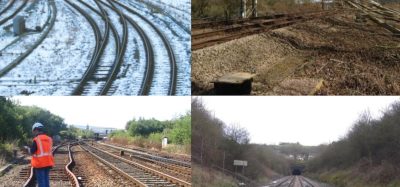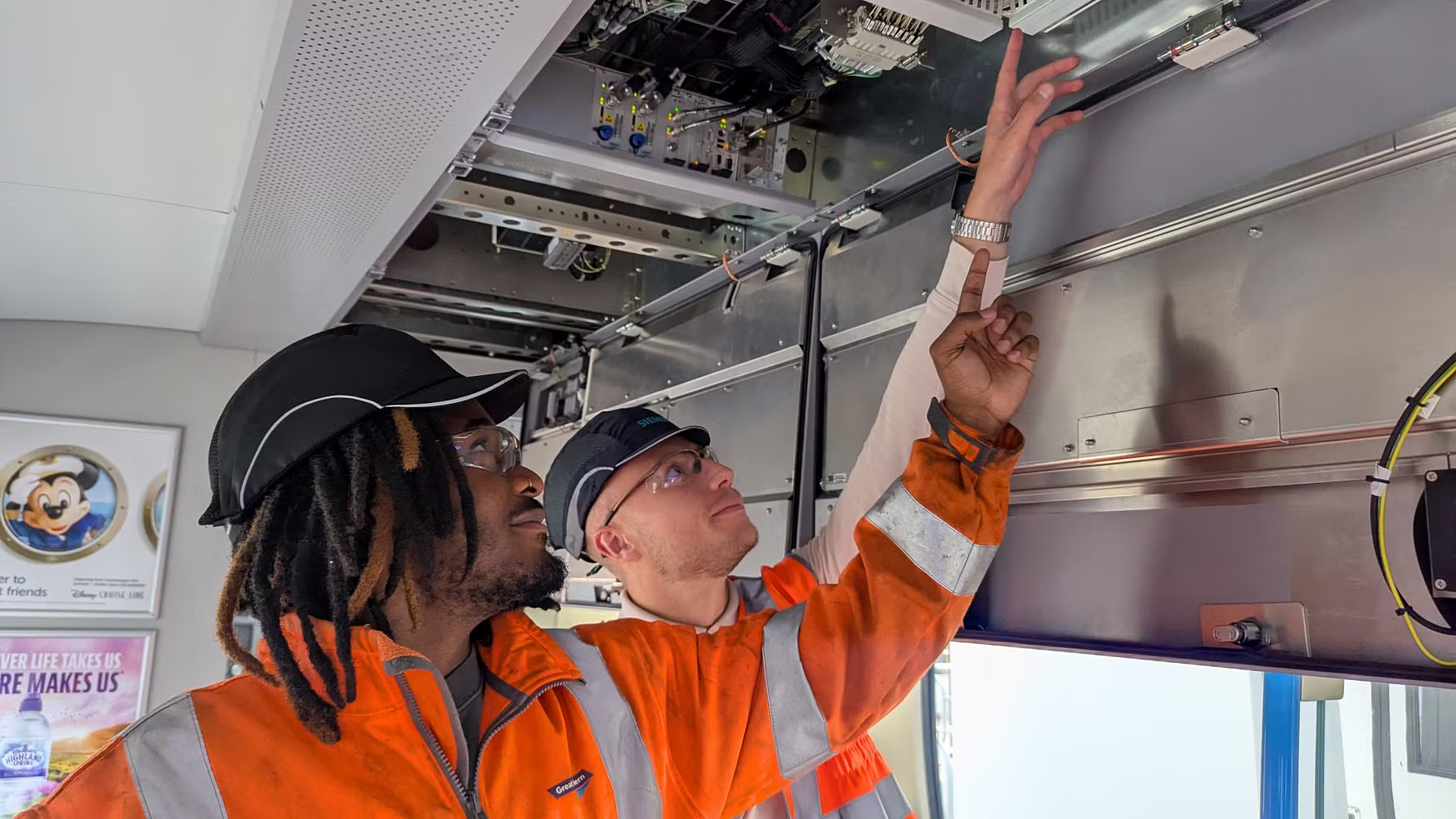Status of ERTMS/ETCS on the Mediterranean Rail Freight Corridor
Posted: 28 November 2022 | Andrea Marrazzo, Claudia Bafunno, Fabio Senesi, Francesco Di Flaviano, Gaetano Ceneri, Gianvito Gallo, Stefano Marcoccio | No comments yet
Colleagues from the Italian railway infrastructure manager, Rete Ferroviaria Italiana (RFI), explain the current status, strategy and importance of ERTMS/ETCS along the Mediterranean Rail Freight Corridor (MRFC).


The Mediterranean Rail Freight Corridor (MRFC) was set up according to Regulation (EU) 913/2010 on 10 November 2013 to strengthen international rail freight transport and promote sustainable mobility by ensuring the necessary international coordination among the rail infrastructure managers and allocation bodies interested in its alignment. According to Regulation (EU) 913/2010 concerning a European rail network for competitive freight, nine initial Rail Freight Corridors (RFC) were identified to improve international rail freight transport, increasing market competitiveness and rising the rail market share against less sustainable transport modes. The other two RFCs – RFC 10 and 11 – were added at a later stage by Commission Implementing Decision (EU) 2017/177 and (EU) 2018/500, respectively.
The MRFC crosses six countries of the European Union: Spain, France, Italy, Slovenia, Croatia and Hungary. It stretches from Algeciras (south of Spain) to Záhony, located on the Hungarian border with Ukraine, thus connecting the European continent with Africa and Asia.
The network of RFCs constitutes the European rail network for competitive freight and all RFCs are cooperating together at different levels and in different subjects to make rail more competitive and attractive.
ERTMS strategy along the Mediterranean corridor
The implementation of ETCS on corridor routes is one of the fundamental goals of the MRFC that is committed to fulfilling the interoperability criteria defined in the Directive 2008/57/EC; in particular, in order to comply with the control command technical specifications for interoperability, MRFC is currently deploying ETCS (European Train Control System) on its lines, according to the infrastructure managers’ implementation plans.
MRFC ERTMS Working Group
The MRFC crosses six countries of the European Union: Spain, France, Italy, Slovenia, Croatia and Hungary. It stretches from Algeciras (south of Spain) to Záhony, located on the Hungarian border with Ukraine, thus connecting the European continent with Africa and Asia.
The ERTMS Committee was launched in 2007 following the creation of the EEIG Corridor D (first the name given to the Mediterranean Corridor). The initial mandate of ‘creating the conditions for the deployment and the seamless use of ETCS on the corridor was fulfilled when the members proposed topics to be dealt with to ensure the interoperability of ETCS trains. In that view, several Working Groups (WG) were defined: Train Categories, Braking Curves, Change Requests, National Values and Harmonisation of Operating Rules. The most important result was achieved by the Train Categories WG that produced, in association with Corridor C, a request for additional ITC (International Train Categories – for ‘Other categories’ (freight train with G brake, freight train with P brake): the request was accepted by ERA (European Railway Agency) during a specific workshop and it is now included in SRS (System Requirements Specification) ETCS.
Regulation 913/2010 envisages among the responsibilities of RFC 6 the development and harmonisation of ERTMS along the corridor. The deployment of the ERTMS along the corridor clearly depends on national decisions and negotiations with the European Commission (EC). On the other hand, according to the experience gained in the last few years, it has been noted that the deployment of ERTMS can bring problems related to the lack of harmonisation between neighbouring countries (due to different adopted versions of ERTMS and different technical and operational national rules that have to be considered). The EEIG for RFC 6 is therefore the organisation supposed to support the efforts at the corridor level for the harmonisation of ERTMS technical and operational rules.
Moreover, according to the inputs coming from railway undertakings, it is necessary to study simplified and harmonised procedures for authorising the vehicles as far as ERTMS subsystems are concerned. Finally, with the ERTMS breakthrough initiative proposed by the EC with the objective of defining short-term achievements and the way to have a reliable and stable ERTMS system, it is pushing corridor organisations to have a proper structure to deal with it.
ERTMS on RFC as a pioneer
In the MRFC it was possible in the past to rely on different ERTMS/ETCS Pilot Projects as Level 2 Baseline 3 on conventional lines in Italy (Milano Lambrate–Treviglio) or the Level 1 International Section Őriszentpéter–Boba (102km) between Slovenia and Hungary and overlapping L1 and L2 section between Őriszentpéter and Zalacséb (Hungary). These activities tested the dynamic transition between different national applications and the implementation of ERTMS L2 on conventional lines with optical signals as well. So, the ETCS is an opportunity for a railway undertaking to use its own rolling stock and act with open access, opening up competition and potentially bringing prices to market level.
Interoperability
Until the deployment of ETCS, railway undertakings have to change their locomotives every time they cross a border, or they have to equip these locomotives with multiple and expensive onboard control command systems. The first choice has a negative impact on travel time and on rolling stock management, while the second one is expensive. With ETCS, they will be able to use locomotives that can run from the origin to the destination with a single onboard control command system. This will facilitate asset management, save journey time and reduce costs.


ERTMS equipment progress
Until now, the railway development and lines upgrade, guided by the national plan of each state, were brought to the ERTMS upgrade; with this vision it was possible to equip several lines of the corridor, looking up to the interoperability at the border section and the desire to homogenise the equipment along all the corridors, so today we can say that there is a good starting point looking at a complete ERTMS equipment within 2035. Now we can look to speed up ERTMS equipment due to the project financed by the Recovery Plan and Next Generation EU, this gives each member state and infrastructure manager the necessary funding and proper scheduling for improving the railway network. This involves a great opportunity for the railway sector and MRFC but also a great challenge for the infrastructure manager. This high focus on ERTMS development, by the EC, has meant that the member state has started work of close cooperation in order to optimise the work of this WG.
In the following schematic maps, we can see the evolution of ERTMS equipment along the MRFC up to the target date of 2035, from there we aim to bring out the expected effort from each infrastructure manager in order to reach the complete equipment of the line.
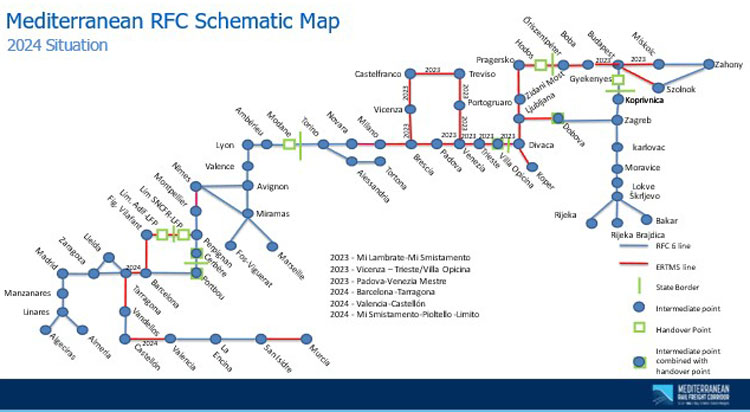

The national plan scheduled for 2024 is to complete ERTMS equipment in the Slovenian line and Spanish lines, for the Italy line by the Novara to Slovenian border, and the border line between Slovenia and Hungary, as shown in the figures.
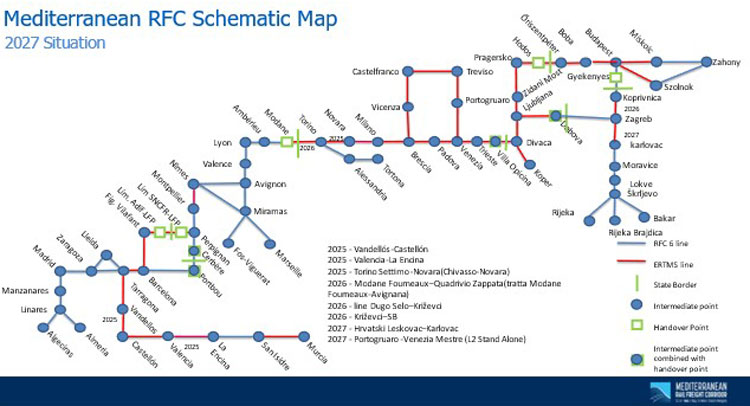

In 2027, the Italian and Spanish equipment will almost be completed, as seen in the figure, with the borderline at Modane and the Spanish core network, and Hungary will complete the Budapest node.
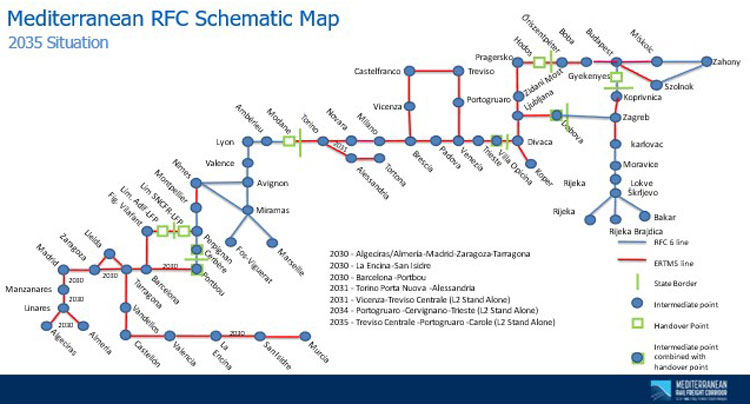

In 2035, the ERTMS equipment for Italy and Spain will be completed.
Technical solution
One of the most challenging points was that the ERTMS system would be implemented along the corridor with different baselines: Spain, Slovenia, and Hungary adopted the BL2, and Italy and France adopted the BL3. This other version will be maintained, guaranteeing interoperability, the main target thanks to System Version Management (SVM). This system compares the baseline of OBUs with the trackside BLs. It is necessary to emphasise that the objective of MRFC is the harmonisation of all the elements coming by each member state and never imposing choices on them.
Another important point is the equipping of the border stations between the various national railway systems. These stations represent ‘points of discontinuity’ on the corridor and require special attention by ERTMS engineers in order to ensure full operability at the borders. Within the technical specifications of interoperability, ERTMS can be customised to the various technological and signalling situations present in national railway systems and at borders, so as to always allow technical interoperability.
Conclusion
The concept with which the MRFC was born is to be the centre where each member state converges its developments with one common scope, ensuring interoperability; this is possible by laying the foundations in the principles of cooperation and collaboration, with a continuous exchange of ideas and information.














Global Railway Review Autumn/ Winter Issue 2025
Welcome to 2025’s Autumn/ Winter issue of Global Railway Review!
The dynamism of our sector has never been more apparent, driven by technological leaps, evolving societal demands, and an urgent global imperative for sustainable solutions.
>>> Read the issue in full now! <<<
Related topics
European Rail Traffic Management System (ERTMS), European Train Control System (ETCS), Global System for Mobile Communications – Railway (GSM-R), Signalling, Control & Communications




